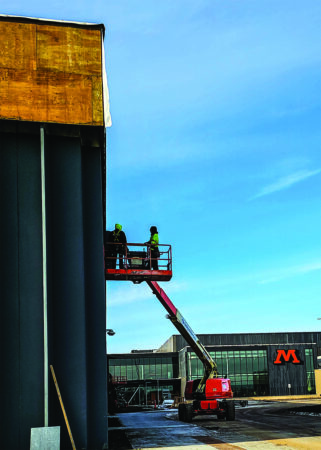- The entrance on the northeast corner of the new high school will offer direct access to the new gymnasium and swimming pool.
- Dr. Brandon Lunak says the Moorhead school district team “had many sleepless nights” when the Moorhead High School project came in one-third higher than had been estimated in 2019, but they succeeded in closing the gap by tapping a variety of sources and options. (Photos/Nancy Hanson.)
Nancy Edmonds Hanson
A new day dawns for Moorhead High School on Jan. 4, when teens return to class in a brand-new landscape. But that bright beginning also marks a victory for the Moorhead school district – a triumph over the unpredictable challenges posed by building throughout the pandemic era.
More than three classroom wings, a vast commons area, and athletic facilities have gone up. The entire project, including both the Career Academy and the reimagined Moorhead High, was initially estimated to cost $110 million. Instead, buffeted by the unpredictable forces unleashed by the worldwide contagion, the final number came in at $142 million, fully one-third higher than originally envisioned.
“COVID-19 wreaked havoc on this project,” observes Dr. Brandon Lunak, who has served as superintendent of schools since 2018. “There have been a lot of sleepless nights.
“But we promised the public a certain type of facility to educate their children. Moorhead voters trusted us … and after a lot of worry, we found ways to deliver what they were promised.”
In 2019, Moorhead voters approved the largest school bond issue in the city’s history. Seventy-six percent voted “yes” for $110 million to replace the age-worn high school with a stellar modern facility, larger in size and scope than the institution on Fourth Avenue South where three generations of Moorheaders had received their diplomas.
All went well through the first part of the project. The Moorhead Career Academy emerged from the site of an empty big-box store along Interstate 94 while the pandemic began to run riot through the construction industry. While pricing began to quake due to the cost and availability of materials and labor, Lunak notes that the district already had contracts locked in.
“If we could have predicted the future, the district would have done the high school first,” he admits. “But the Career Academy was the easier project of the two, with the shell of Sam’s Club already there, so we did it first.” The Career Academy’s total cost was $23 million, saving nearly $32 million over the cost of traditional construction.
“But then COVID came along,” the superintendent says ruefully. “Costs escalated. Contractors faced all kinds of supply-chain issues. No suppliers were willing to guarantee a price three years out. They wouldn’t even do for two months.”
That affected three of the five bid groups that had yet to be issued. Three remained as costs soared. “We had to pull back and rethink everything,” he reflects. Hard choices were made to reduce the overall scope and cut costs while staying true to the kind of facility that had been promised, not just to voters but also to the MHS staff and students. Removal of the proposed athletic complex cut the price by $5 million, a move that covered the addition of the competition-level swimming pool east of the educational wings.
The second and third bid groups came in far above what had been projected, but the cost-cutting steps paid off in the fourth and fifth bid groups. The fourth bid package came in near the estimate, while the fifth and final bid package came in below.
So where did the district find the money to close the gap between the bond issue and real-world costs?
“We looked in every bucket we could find,” the superintendent explains. “We went to the Legislature for permission to spend certain earmarked funds we already had.” He credits Sen. Rob Kupec and Rep. Heather Keeler for securing approval for a one-time transfer of $5 million from the district’s long-term facility maintenance fund to operating capital, a move otherwise for construction.
Because the Career Academy structure was moving from a mercantile to an educational use, its HVAC system required $6 million in upgrades. The Minnesota Department of Education, however, had rules that prevented the district from accessing health and safety funding. Since that sort of funding is a part of the Long-Term Facility Maintenance Program, the district wasn’t initially allowed to gain access to it, since these funds are not typically allowed for remodeling or new construction. Again, the legislators stepped in.
“We feel so blessed they took up the challenge,” Lunak says. “Due to their support, the district was permitted to utilize around $6 million of the health and safety funds for the HVAC improvements at the Career Academy.” (Fergus Falls, where a Target store was undergoing a similar refitting, also benefited from that ruling.)
Other legislative adjustments brought more good news. Long-term facility maintenance funds could be used to construct secure, privacy-enhanced bathrooms as part of the new school. “The design was about improving student safety and reducing vandalism,” Lunak says. “Our architects came up with a concept that should address these challenges.”
Federal COVID relief money, too, helped pay some costs. About $7 million in ESSER money – Elementary and Secondary School Emergency Relief Fund – was utilized to construct vocational labs and purchase equipment for the Career Academy’s labs.
Carry-over from the bond issue that built Dorothy Dodds Elementary and Horizon Middle schools, passed by the voters in 2015, could also be applied to the project. “We needed our construction teams to design and build both schools at the same time due to the shortage of space we were facing. That move saved the district about $3 million that has been applied to the gap,” Lunak stated.
Other smaller steps contributed, too. The former bus garage on 12th Avenue North, which had been replaced by space at the Operations Center on 30th Avenue South, was sold; that brought in $330,000. The federal ERATE fund covered allowable technology equipment, while the food service fund was used to cover a portion of the costs associated with the kitchen equipment.
A $6.5 million abatement bond was used to cover the construction of the parking lot. After the old high school is demolished this spring, cars will inherit the spot where it now stands.
When two land parcels that the school district owns have been sold, the proceeds will also help. One parcel encompasses 80 acres near the Oakport area; the other 40-acre plot is just east of Dorothy Dodds Elementary.
The result of these and other decisions will be on view to the community on Sunday, December 17, when they get their first glimpse of what Moorhead voters and the district have accomplished.
“When families walk through the high school, they will see the facility that was promised in 2019. Thanks to the hard work of many people, the community will witness a facility that has overcome numerous challenges to complete this project as promised,” Lunak reflects. “I’m still honored by the support that our taxpayers are willing to invest for the sake of our students.
“Now, I may be biased,” he adds, “but due to the support of our community, I believe our high school facility will rival not only any high school in the region, but in the entire Midwest.




